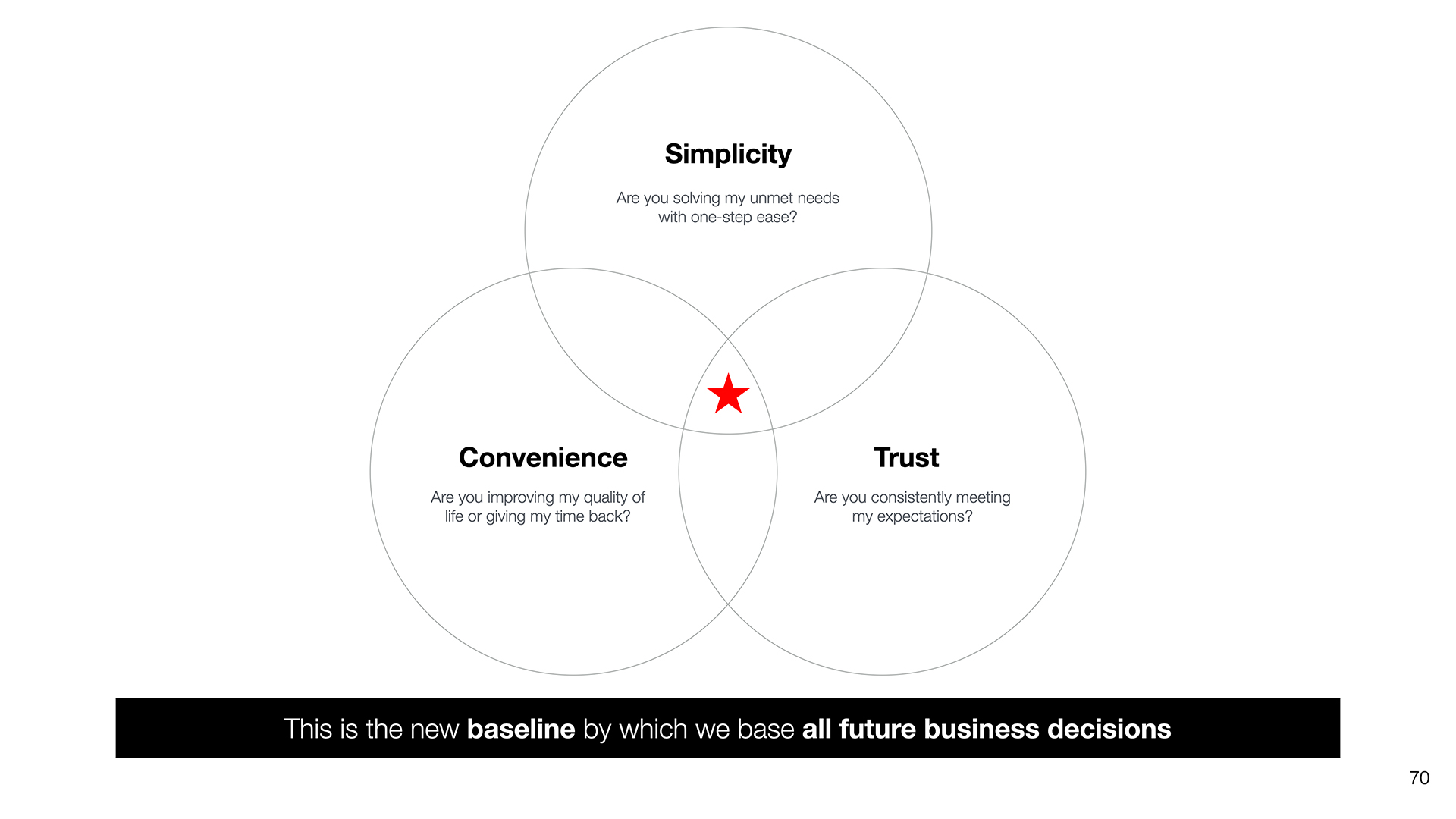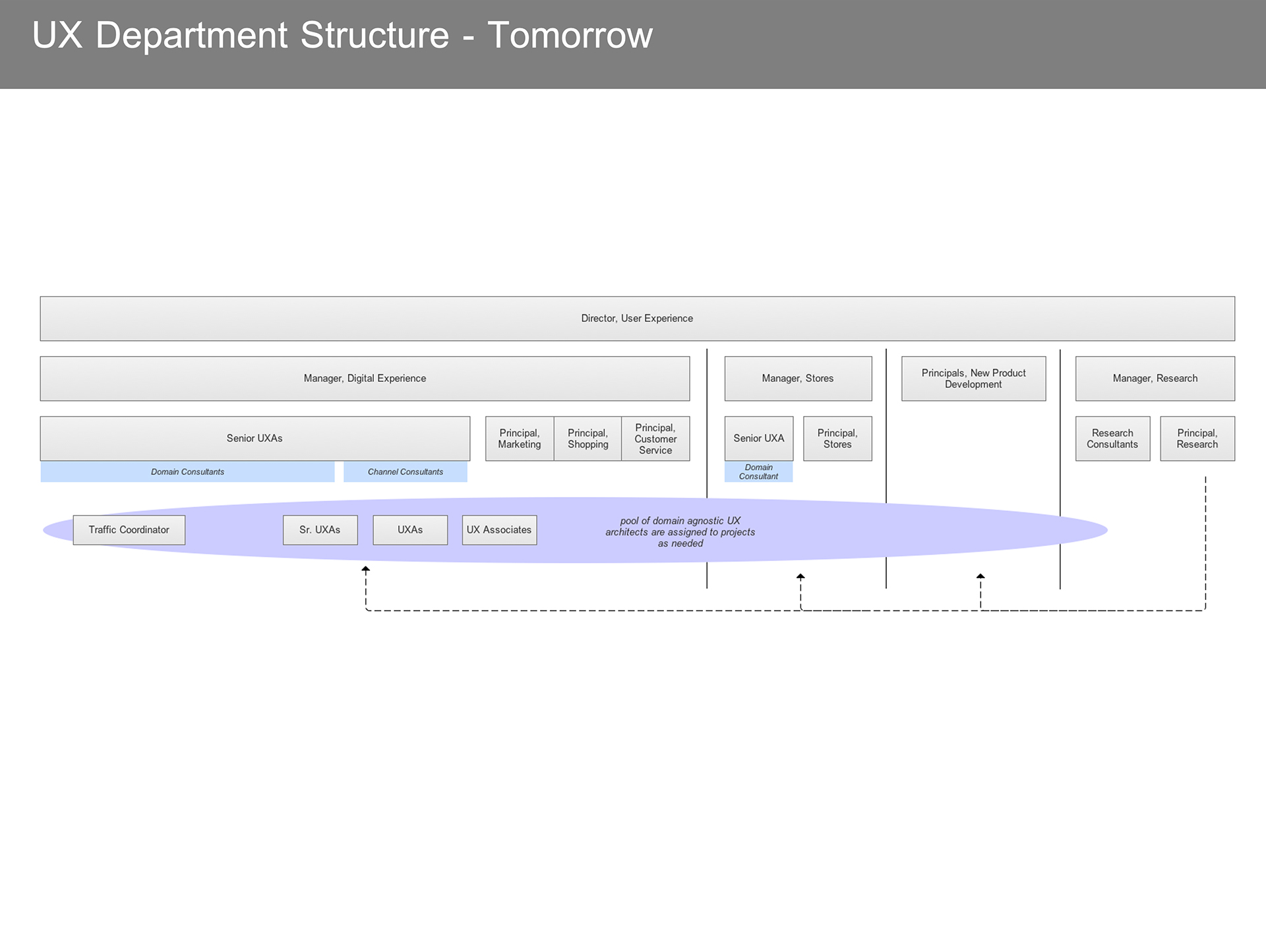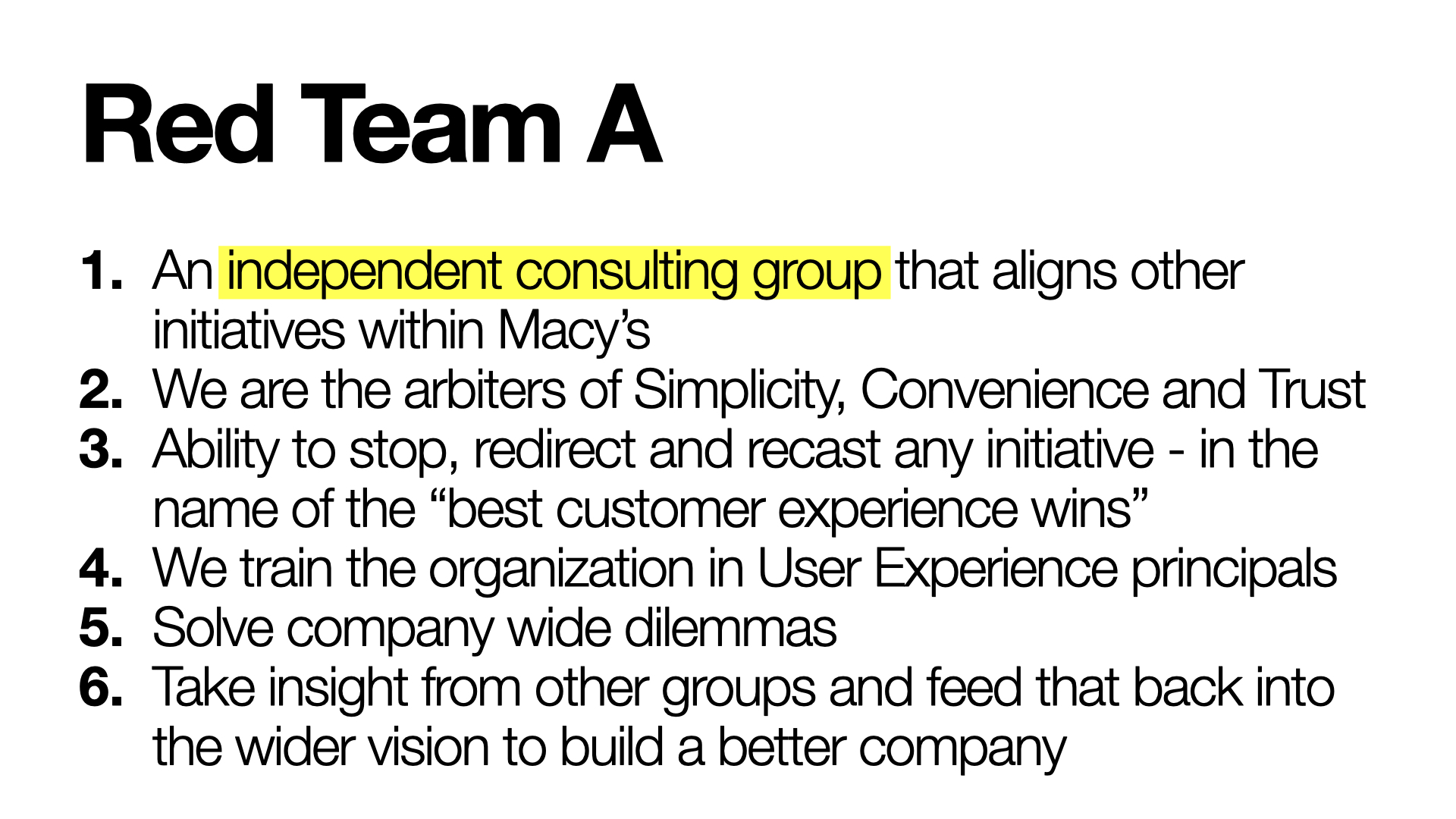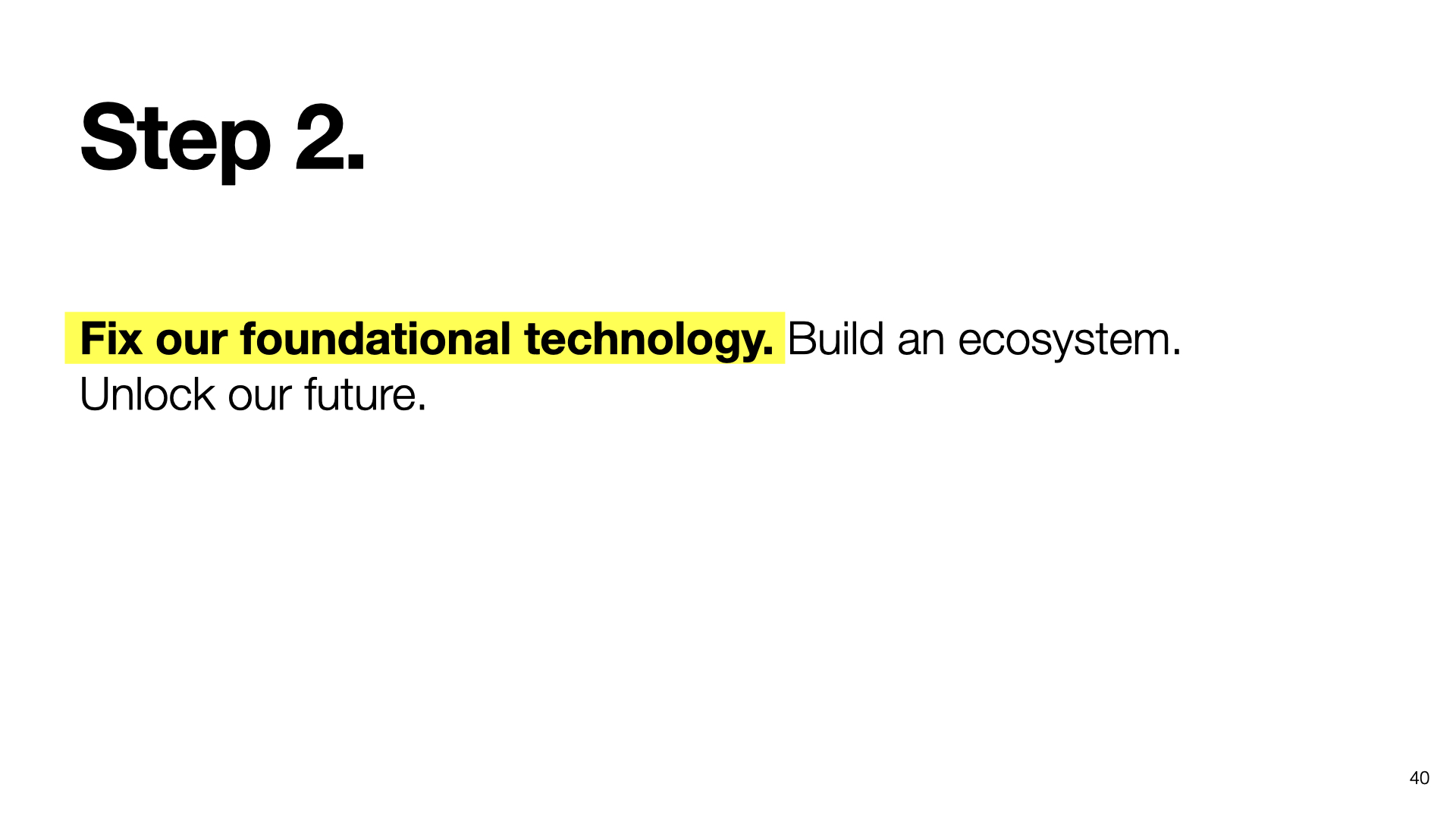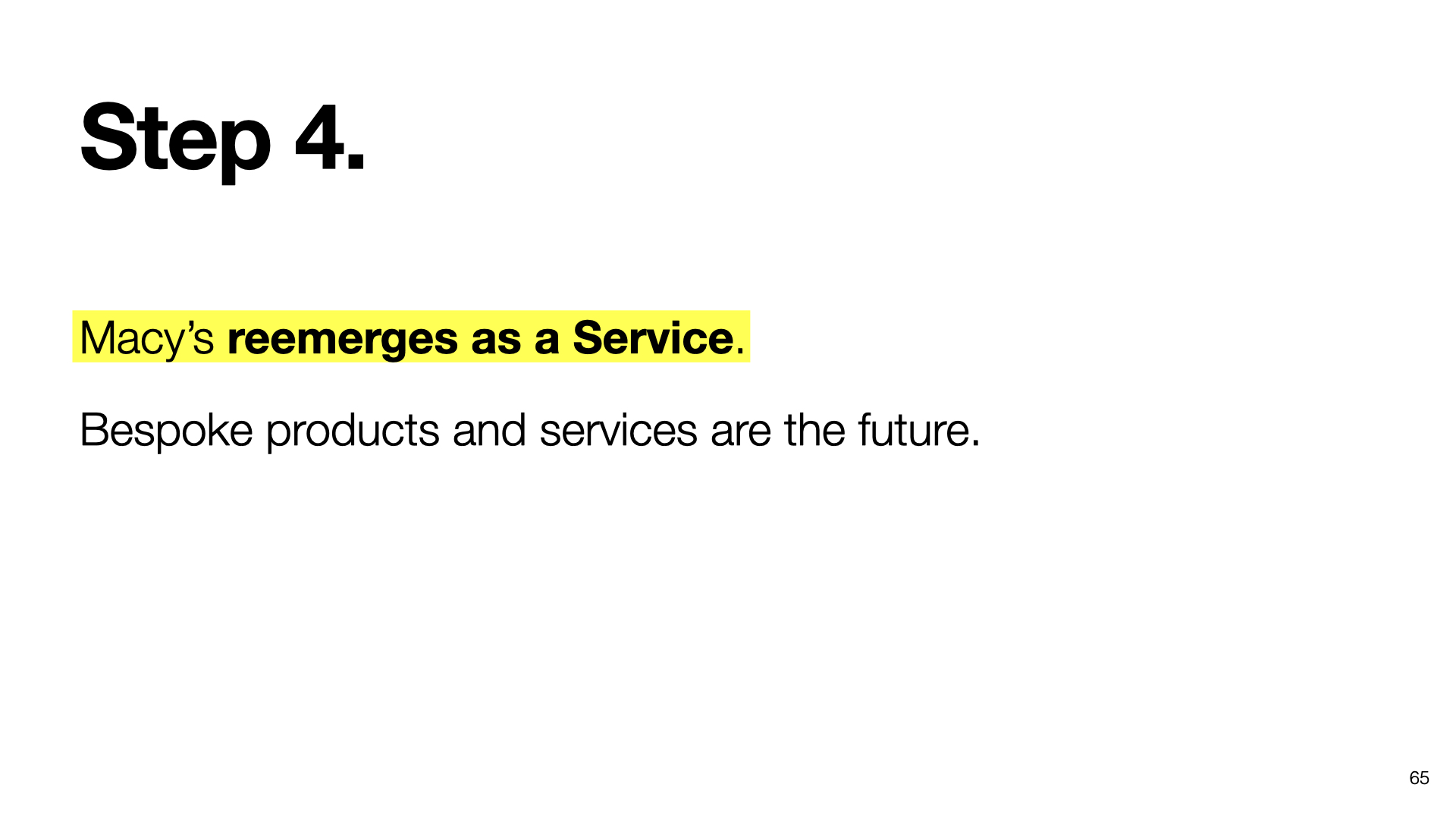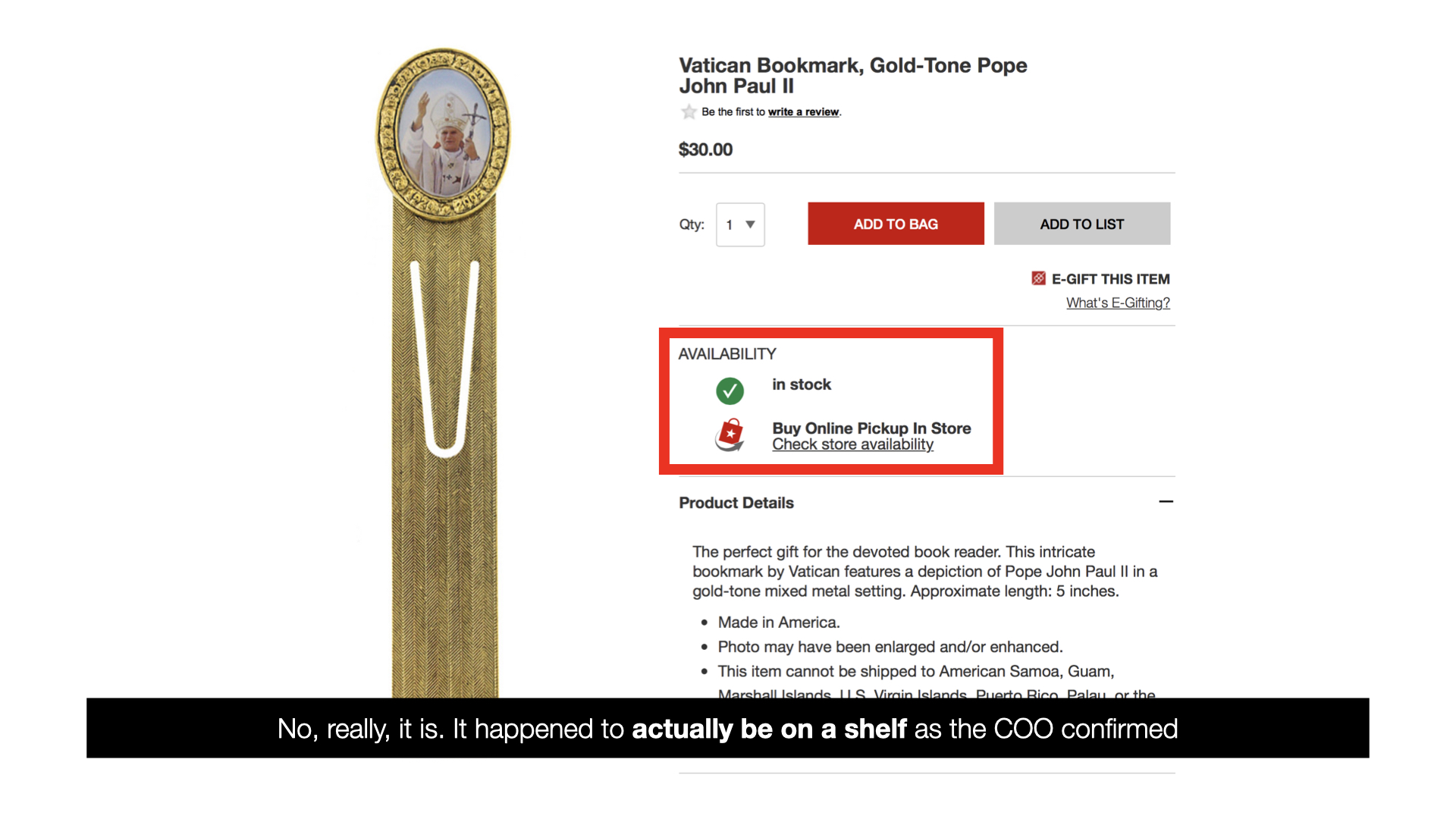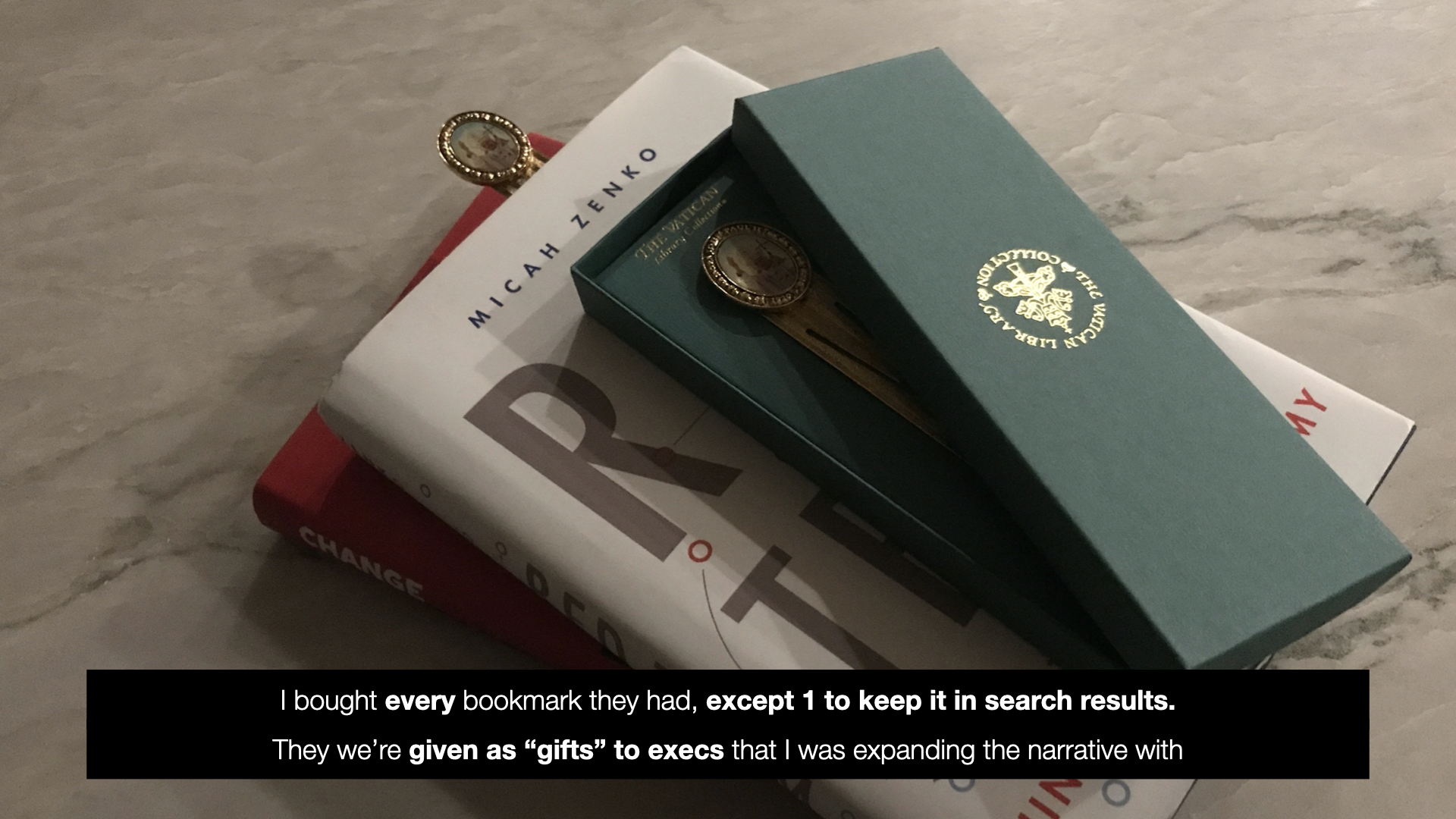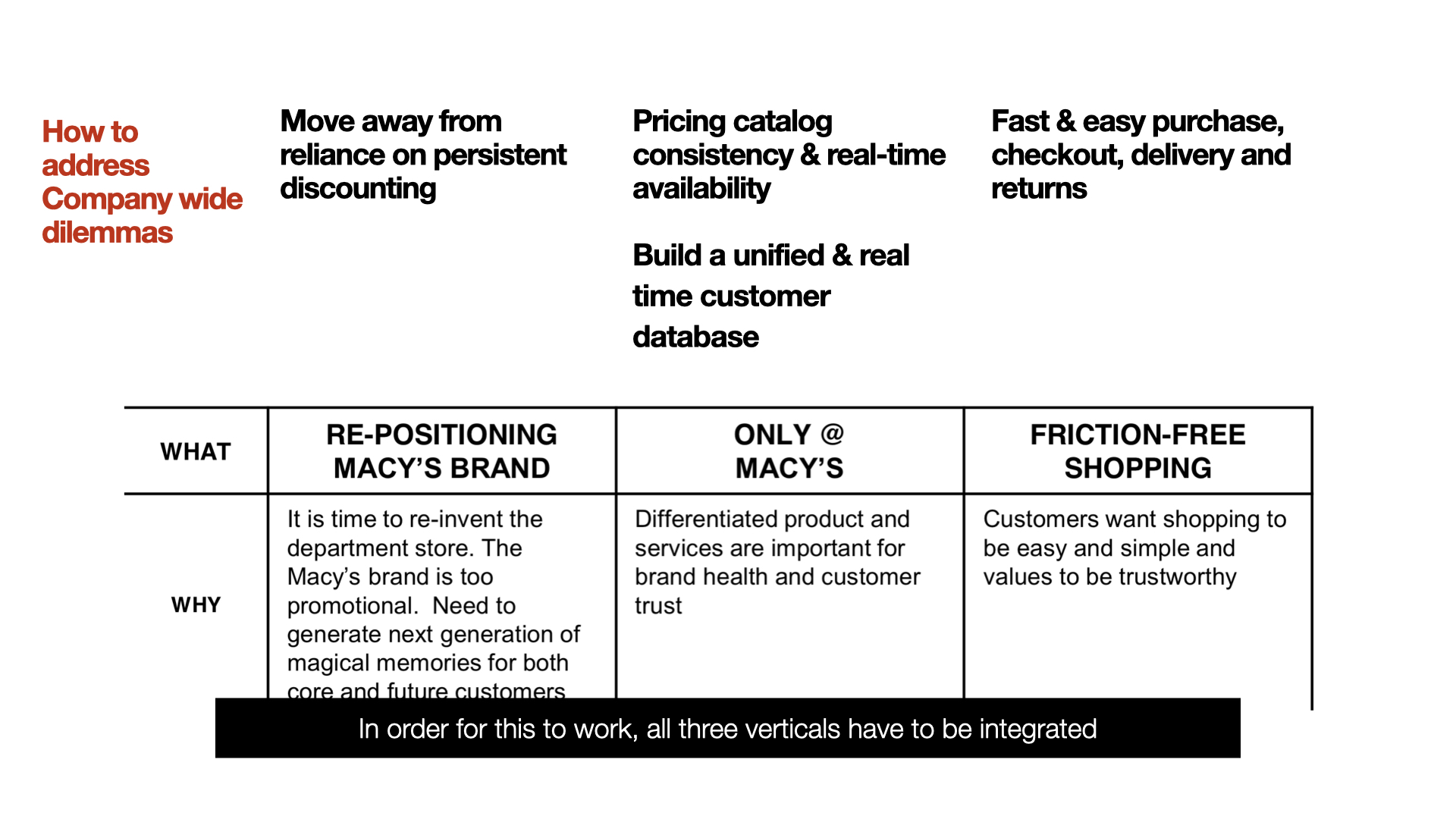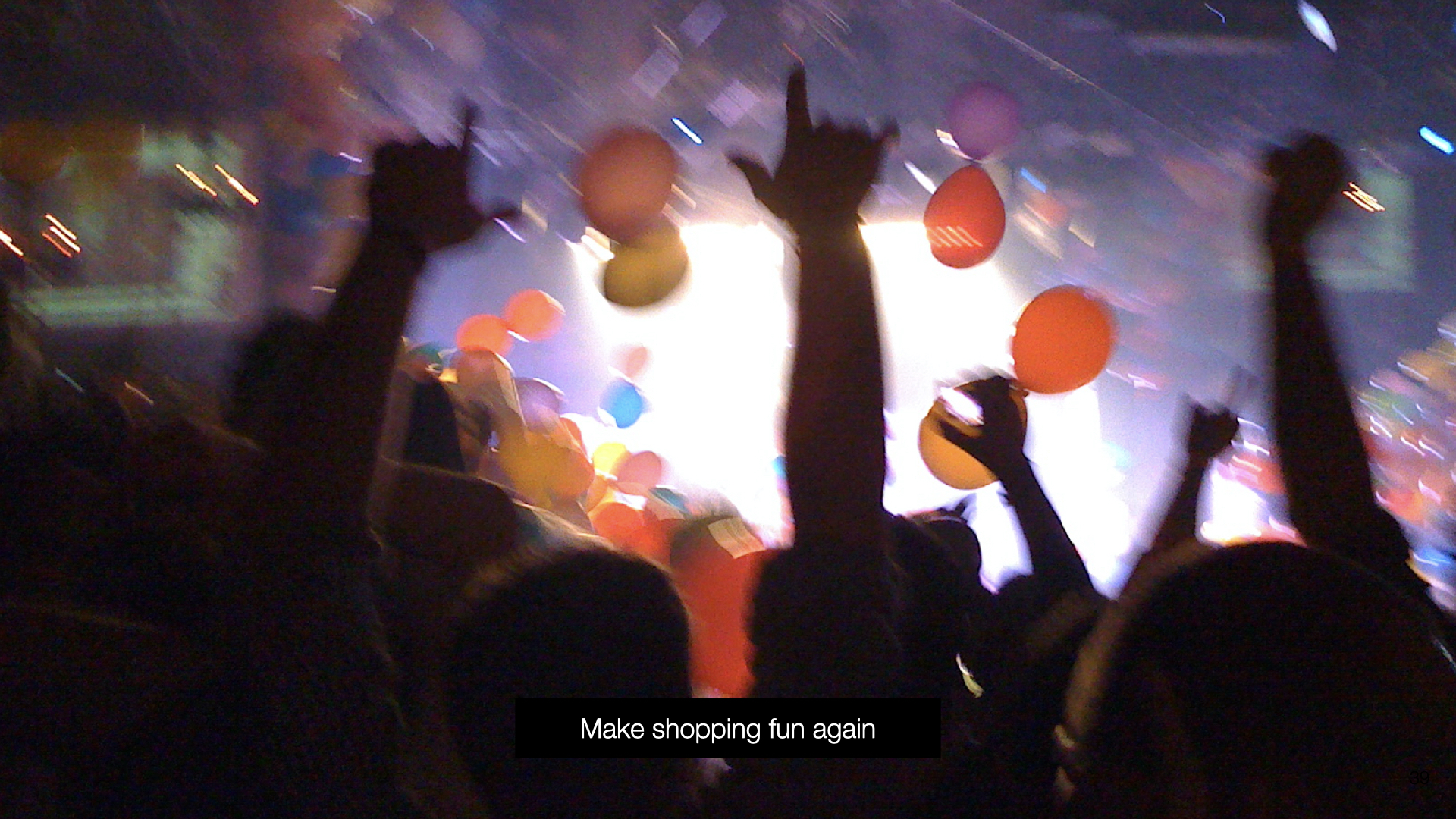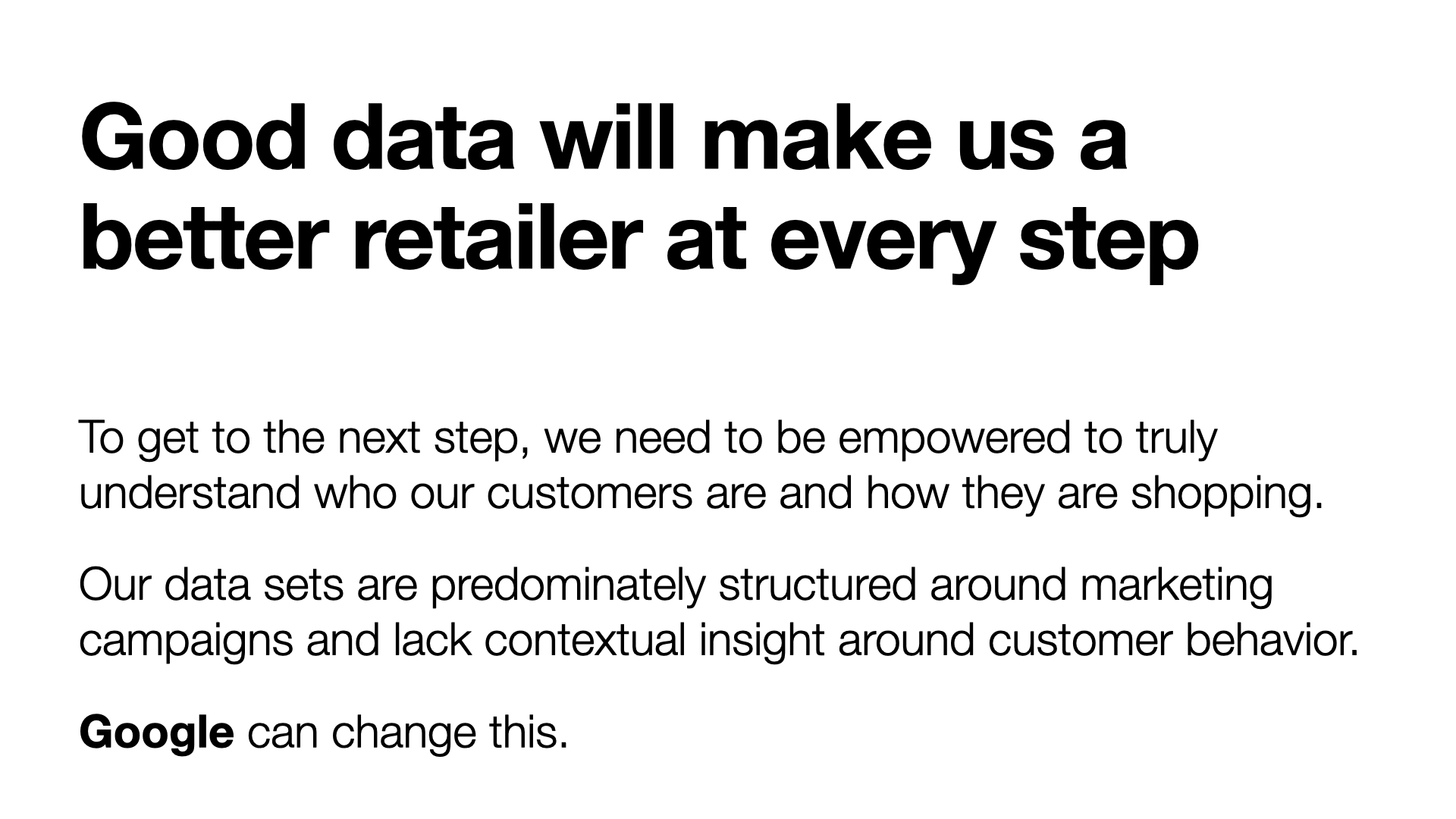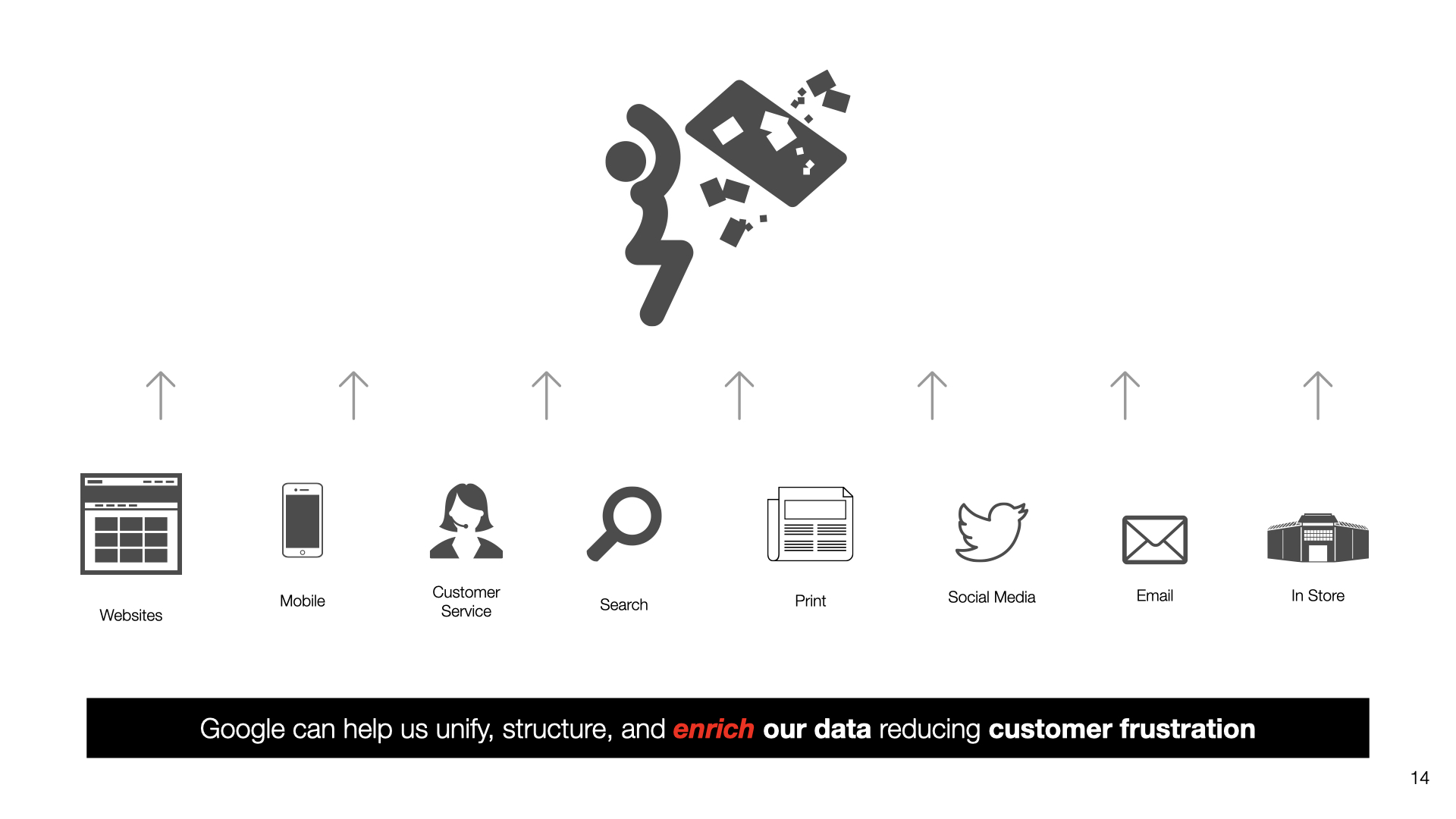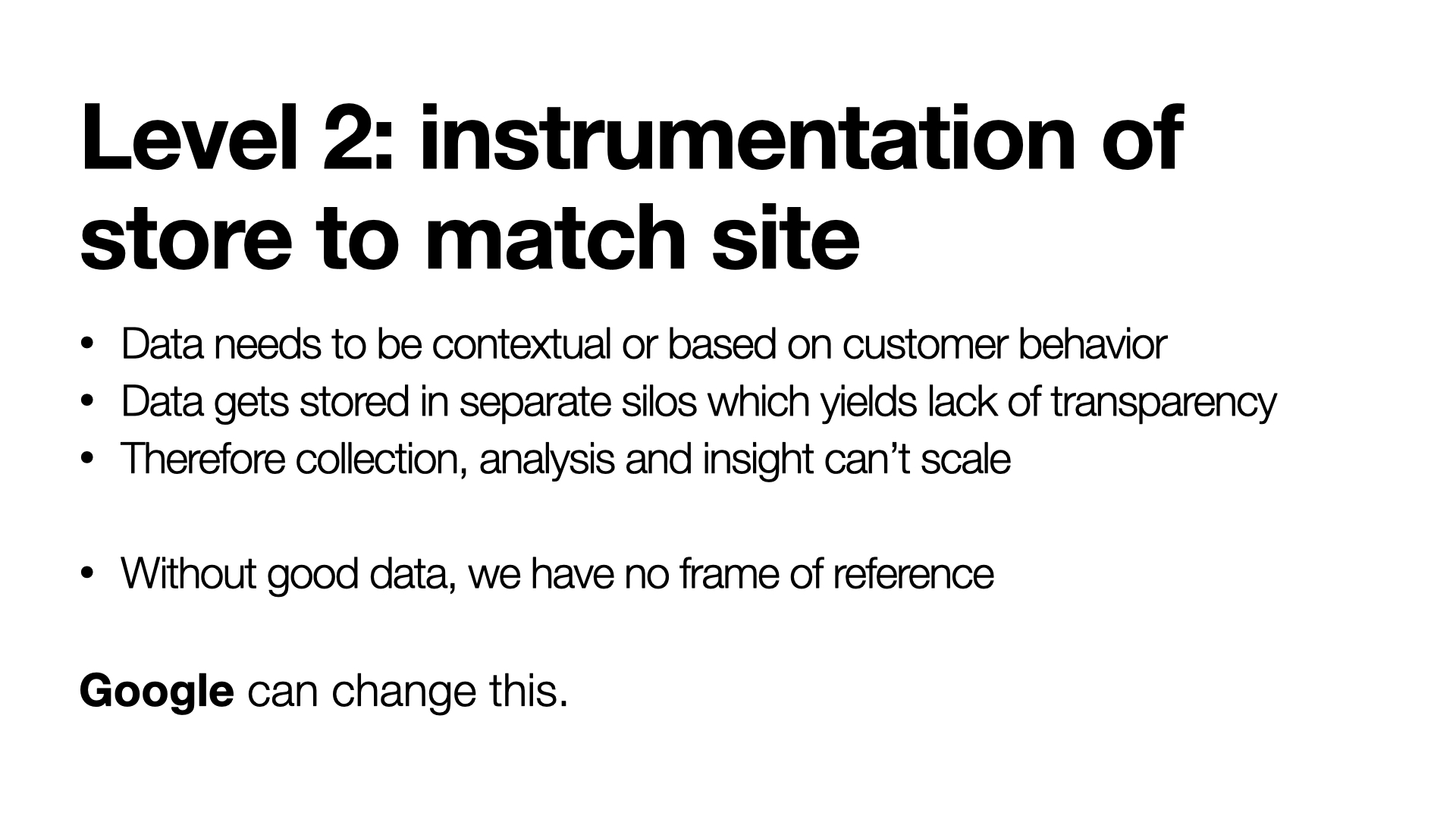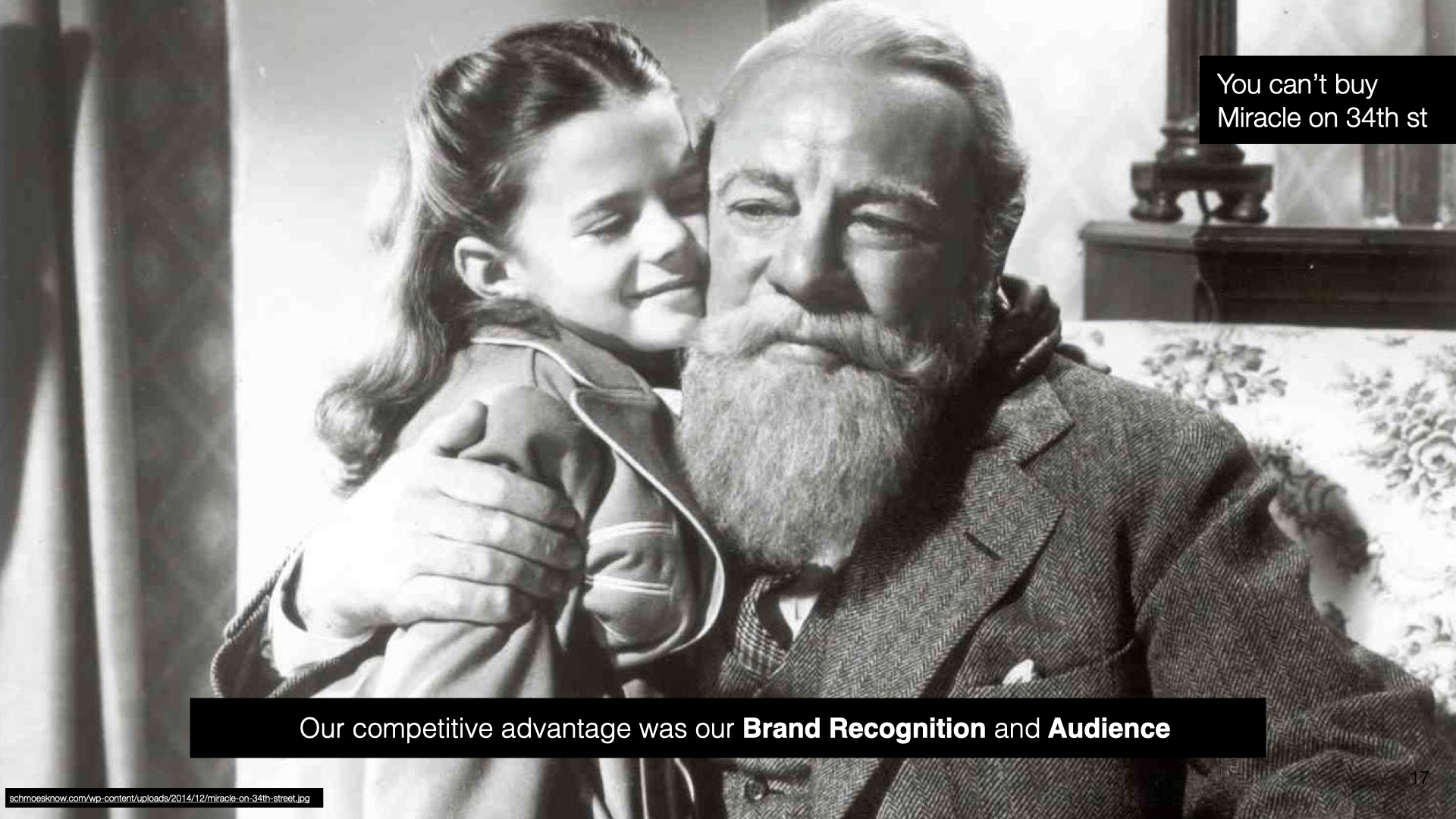The Best Customer Experience Wins
The new vision for Macy’s was simple: the best customer experience wins.
By taking all of Macy’s disparate components and reorganizing them into a retail API, you unlock multiple flywheels to generate value across the entire value chain.
In programming, an Application Programming Interface (API), is a way for software and services to speak to each other - almost like interchangeable Lego bricks, but for retail.
Making Macy’s an open API for retail, effectively enables anyone to become a merchandiser, producer, marketer, or customer - all while collecting and monetizing the data to make the whole system smarter (Culture Flywheel).
Aside from the massive customer experience upside, SaaS companies also trade at a multiple of revenue vs multiple of EBITDA (just ask Scott Galloway).
This innovation would bring Macy’s back into its roots but with a modern twist.
Every Interaction Makes The Brand Smarter
Instead of a classic merchandising and marketing funnel, we wanted to transition the business into a human centered flywheel.
Every customer interaction should make the whole company smarter (the same way every Google search makes their algorithm a little bit smarter).
The evolution is slow at first, but over time, the service improves exponentially, and builds a moat around the business.
This is how you build the best customer experience in retail.
By tracking the brand touchpoints anywhere, you improve the experience everywhere.
This is how you transition a multi-channel experience into a true omnichannel vision.
One which lays the foundation to build the best customer experience that only gets better with time.
Macy’s CEO Jeff Gennette recently reiterated this commitment on data and relationships:
“The focus is shifting to the individual customer and how we can develop a deeper relationship with her by anticipating her needs, solving her problems, and using our data to personalize our messaging and offers to address her specific interests.”
Every Interaction Makes The Brand Smarter
In the Economy of Attention, data is a gold mine.
With the impending demographic implosion (worldwide), data will become the only infinitely renewable resource that gets monetized and fed into better AI models - which in turn helps improve the overall customer experience.
By paying people for their data, you unlock a host of new capabilities for the platform.
The primary driver enables a new loyalty program (star rewards upgrade) where all interactions are converted into points, and thus can be redeemed for store credit.
This helps not only with feeding our data models, but also by removing exclusions with luxury brands, by using points as payment instead of sales which devalue the brand.
This is super important because exclusions were a massive pain point for shoppers (see checkout below).
Today Star Rewards does something similar, however your points expire in 30 days which is not a great customer experience.
Macy’s coin as a new cryptocurrency would keep all the new value within Macy’s ecosystem.
Selling Brand Intelligence Back to Vendors creates a new revenue stream as well as leverage in future negotiations with brands.
No one had our generational sales data because the data wasn’t just from online, but from each of the physical stores all over the country.
Geotagging sales could provide near real-time trend analysis by feeding our data models.
Make collections of subscription boxes (limited runs down to specific locations) that get better over time because data would tell us what was selling where to specific demographics and where.
Trading in old clothes for points could provide a potential tax write off as a donation, or be resold to the right people via AI to match style / fit / need with the right person.
LuluLemon is doing something similar, while Victoria’s Secret is dumping excess inventory instead of donating it.
Macys then sells those back to the right people at the right location at the right time, because we’re tracing all the data and building deep customer profiles based on a lifetime customer vision.
Directly pay customers for good reviews that led to sales or other valuable brand interaction.
Another method would be to pay people per month based on their “data credit”, i.e. using their data for analytics to sell back to brands over time.
More data with Macys for longer = more cash in hand per month.
Customers can get recruited and compensated for interviews, focus groups, modeling ops, influencer opportunities, or even flexible employment needs (think tailors or style consultants).
Haulers and Influencers can create content that aligns with the right user segments.
Products and services are bought from Macy’s, and advertise (and sometimes educate) on our website and social media channels.
Purchases can be traced back to this video content to connect where conversion came from.
If a customer goes into the store and mentions the service that brought them there, associates can update the data model in real time.
Haulers (from tik tok) (tank top into a skirt)
Epic tweet from older woman - gold boots on tiktok (tweet) (tweet 2)
How Live-streaming Ecommerce Works in China - Napkin Math - Every
A QVC type model where a “live channel” is broadcast on Macys.com as well as youtube can unlock other potential sales.
Live shows could even be recorded in marquee locations to yield multiple orders of value. (see china article above).
Influencer economy = How livestreaming QVC could be Macy’s (have example from Amazon).
Why Organizations Fail
It’s no secret that trying to change corporate culture is hard.
Large corporations are complex systems and fundamentally averse to change.
This reluctance is rooted in a misalignment of shared vision, shared values, and shared culture within the organization.
Whatever your organization’s innovation was in the past will evolve into costly legacy issues over time.
This is the natural process of growth and happens to every successful organization (see The Innovator’s Dilemma).
This reluctance is rooted in a misalignment of shared vision, shared values, and shared culture within the organization.
The challenge most large companies face today is that if they don’t adapt, they will go out of business.
However, the company simultaneously can’t change because of a misalignment of shared vision, shared values, and shared culture within the organization.
The salient dilemma then becomes, how do you build a shared vision and shared culture everyone can get behind?
Put The Human Back In The Loop
The key is that you need to design for human-centered systems at all levels from employee to customer, and the market.
Then take into account their unmet needs, points of friction, sentiment, and varying perspectives of success.
This human-centered approach will reveal the vast spectrum of value systems intrinsic to the whole system.
Shared Vision + Value System = Carrier Wave
In order to successfully transform a business, you need to architect a shared value system and shared culture that fulfills three criteria:
First, you have to solve unmet customer needs simply. Customers are the lifeblood of your business, without them your company won’t exist.
Second, you need to understand what it takes to build a great company that is profitable. This enables the business to reinvest in itself for continuous change and innovation.
Third, you need happy employees that take pride in their work and positively contribute to a shared value system and shared culture that continuously learns and embraces change.
All three criteria for customer, business, and employee are necessary to effectively change your corporate culture.
In order for any influence operation to work, you have to connect the CEO’s value system, with what the market values, through your organizational culture, down to your customer’s unmet needs (what they value).
Mapping the architecture of power and understanding how continuums of scale, time, and expertise modulate an individual or group’s mental models will be essential.
The architecture of power illuminates general dynamics within the corporate culture, which are analogous to tides in the ocean.
They can’t be controlled but are very predictable, therefore they can be creatively leveraged.
Change Management As Tetris
The secret sauce to influencing corporate culture is by solving multiple unmet needs simultaneously in a coordinated manner that aligns everyone towards the shared vision and shared value system.
This is a very subtle method to induce change without disturbing equilibrium because you are pushing the value somewhere that no one is anticipating (towards the shared vision), while everyone myopically focuses on how to maximize their own immediate short term benefit.
Everyone wants to look like a hero in front of their boss, and as long as you have been following the outlined framework, you will help them do just that.
Eventually, you will be asked to present in someone or some group’s more important meeting (usually a quarterly review with a big boss).
Modify your presentation deck and cater the message specifically to the unmet beads of the group you are presenting to. This applies the shared vision and shared value system to their context.
If successful, your presentation will become a currency for that person because no one up to this point has been able to visually illustrate the problem with such ease.
Rinse & Repeat
If done properly, the cycle repeats and other managers will ask you to come present and make them look great in front of their bosses.
Other managers or leaders will “borrow” from your deck and use it in their own presentations because they will want to take credit by showing how they are solving the company’s problems to their respective bosses.
This is how you implant and share the vision and value system throughout the rest of the organization.
The higher up the chain of command you go, the more important it is to connect your micro level solutions with the macro level of the business, industry and economy as a whole.
Very few people are thinking holistically about the company, let alone taking the time to develop a cursory understanding of how basic corporate finance and macroeconomics work.
This will help your message carry far because understanding the financials will support and validate the shared vision with an audience that actually cares about and is measured by financial statements (framing effect applied to their value system).
Eventually, the CEO will find out and with a little luck you will have the opportunity to present directly to the CEO.
Macromedia Offsite
The journey to rebuilding Macy's corporate strategy started with a work trip to San Francisco.
There was a real need to get fresh thinking and change the air, so my boss asked me to come out for a week to brainstorm the dot com strategy and see what was possible.
Our workspace turned out to be the old Macromedia offices (pre Adobe acquisition), so it was ironic that we were building the future Macy’s vision there.
Two whiteboards synthesizing all the pain points on Post-Its below. We worked in parallel, collecting data and refining the key breakdowns.
Cam (my boss) brought another director with him to the offsite, and it was clear from the jump that they were both demoralized from a lack of progress within the organization.
Juiced with a quad espresso and fresh cigarette, I was ready to hop into action.
I started asking lots of questions and having the three of us write out challenges and opportunities on Post-It notes.
Post-Its quickly became groupings of opportunity (if Macy’s changed), and those revealed a set of company wide dilemmas that were preventing the entire organization moving forward as a cohesive whole.
I soon discovered that the company culture was so complex and so riddled with legacy issues - that you needed to restructure everything in order to change anything.
I rolled up all the big sheets of paper with Post-It note groupings and installed them in my hotel room.
That translated into a bulleted outline, almost like keyframes to tell the future story in five vignettes.
Company Wide Dilemmas
As we exploded all the pain points and possibilities within Macy’s, a handful of company wide dilemmas emerged.
Sliding the Outline Under The Door
After outlining the talking points for the deck, Cam slid the outline under the door of his boss’s boss during a key meeting.
They skimmed the outline, and almost immediately asked for the deck to see the vision in action.
We had initially only been tasked to redesign the dot com strategy, so when they saw that we reinvented the whole company - they were ecstatic.
Cam’s bosses quickly realized that in order to transform the dot com side of the business, you had to transform all of the business.
Six Vignettes Tell The A Magical New Story
By merely suggesting the idea to change anything even slightly, would be like introducing a cell phone into a medieval town square. Heresy!
Therefore, we needed something visual that was also easy to read and share, so whoever we presented to, they could go and tell the others.
We structured our pitch as six vignettes, each presenting a problem and a solution - like call and response in jazz music.
Adaptability is Key: Today we’re about as inflexible as a straight jacket. Fixing our tech is a four letter word, so is cash.
Cultivate Relevancy: Customers have to think too much and work hard just to place an order. Let computers do what they do best, automation and attribution enables customer customization.
Unlock Omnichannel Inventory: Our stores confuse customers (cognitive overload), they’re the physical embodiment of Cultivate Relevancy above. Have stores be playgrounds of the future and warehouse 2.0. Touch physical product, seamless connectivity, faster and easier shipping and returns.
Expand Our Customer Base: We can’t expect to grow and expand to new customers if we don’t understand our current base’s needs, and fail to meet them constantly. Solving those problems simply will enable us to serve millennials, because the shopping use cases are similar.
Drive Omnichannel Adoption: What worked in the past will no longer work in the future. Flexible adaptive systems that enable Macy’s to constantly learn new insights that serve our customers unmet needs will produce excessive profit.
Big Data Big Magic: Today we waste countless hours struggling with technology. Data is the currency of the future, make it work for us - not against us. We’re a people company, we get back there by making technology invisible (seamless) so we can focus on creating for life.
Preliminary Pitch
The intention for the first cut of the deck was to get everyone to understand (in plain terms) what the best possible customer experience could look like, if the organization aligned on a consistent vision.
No one wanted to spend money on that, because they couldn't’ prove ROIC (return on invested capital), plus it was super boring to work on.
Second, why would you want to continue to unlock something that would provide value to everyone else, and not immediately benefit yourself?
The main “ask” therefore became to fix our technical foundations, because that underpinned everything a modern retailer needed to be successful.
It was clear that data was the real engine going forward, but Macy’s was afraid of adopting any tech-company like culture.
The biggest mindset shift was transforming the company’s perspective from an antiquated to an exponential world view.
The same way Google gets a little smarter with every search query, Macy’s needed to become a better retailer with every touchpoint that a customer interacted with.
There was such a severe lack of technical literacy across the organization, so a certain amount of education needed to be done - in order to make everyone understand what was not necessary (from a UX perspective) given how cheap technology was getting.
Next, given that we were so far behind technology-wise - the only way to really paint the future vision was by telling a story.
I had a background in film sound and special fx, so going the narrative route was second nature to me.
The visual narrative addressed all the company wide dilemmas without blaming anyone, and instead said - hey if we recognize these company wide dilemmas, we can rebuild the foundation for a platform of shared awesomeness. This approach accomplished two things:
First, it disarmed everyone because no one got blamed.
Second, it got people’s attention - because everyone knew the company wide dilemmas existed, but were afraid to speak up about them for fear of punishment.
This is why the case started by stating the organizations fail because of a misalignment of vision and value system, because that is what breaks great organizations.
We essentially presented the new business model for Macy’s, but wrapping it up in a storyboard for a film, while also providing a natural place for everyone to see how they could contribute to the shared vision.
Paradox Of Product
We presented the initial cut of the deck, but because everyone was so literal - they wanted to see finished interface designs in order to agree to building anything.
Storyboarding The Visualization
There was another side of this paradox. If we told anyone exactly what to do, they would say no it’s too hard or will cost too much money.
We decided the best approach was to put together a visually compelling narrative that showed everyone what the vision could be.
I worked with an illustrator to put storyboards transposed against vignettes mentioned earlier.
This gave us a frame that we could apply to all parts of the company, while making the presentation accessible to everyone.
The main narrative arc was simple: the world has changed, but we haven’t - if we don’t change - the end is near. Don’t be Sears.
If we do change, this is what the future can look like.
One vignette focused on dynamic inventory movement. The idea was that we could pair a coat sale and move merchandise if a storm was about to hit New York City.
Our character Sally could “preheat” a dressing room with various clothes and sizes of her choice.
If work or life delayed her, she could easily cancel via text message or the app, and arrange via one touch to have an Uber driver drop them off at the location of her choosing.
Whatever she didn’t like, she simply needed to toss it in the box, select the items to return in the app, and attach the included label.
Because the focus was on a large city, we could do a deal to optimize costs to pick up the package from her apartment, removing the need for her to make a trip to the post office or the UPS Store.
We had to show how these foundational fixes could benefit everyone’s unique interest, so we should leverage them and not fear them.
That was the primary ask from the deck, but instead of a concrete ask, it was more of an internal awareness campaign to get everyone to realize what they could gain if they all pulled together to move towards a common goal.
Merch Deck Modification
We had just finished the storyboarded pass of the presentation right before a big yearly planning meeting.
We looked at what were some common site merchandising problems: items not being properly attributed, lots of manual labor including webpage builds, and no content being algorithmically generated.
Chief Merchandising Officer Invitation
The presentation went so well, that we even got invited to present to the Chief Merchandising Officer at a big yearly manager’s meeting (all of merchandising site and store).
The presentation followed a similar flow as before - evangelize the baseline, then show them how our solution solved all their problems.
Everyone wants to look good in front of their bosses, so rinse and repeat - kind of like enterprise sales, but internal to the organization.
Friendly Fire
At this point, the cat was out of the bag (the presentation deck was circulating everywhere) - and we started getting push back from the corporate politics involving other teams.
One marketing team was going to keep adding more sales prompts to the in store checkout flow, even if it increased time to check out, and increased the time to checkout for everyone in line (terrible user experience).
Someone from marketing said if it increased their sales goals even one tiny bit, they would still do it - at least they were honest lol.
We had to adapt and change our approach, otherwise all the momentum we produced would have been completely destroyed.
Our strategy was always to play the long game - even if that meant the organization made progress after our roles were finished.
This is actually what happened, many changes not until much later into 2020 (see Post Covid Prophecies section below).
Incentives across the organization were fundamentally misaligned as well, and if this got fixed - everything else would fall into place.
Change Management Tetris
What we had to do was seed social capital to specific groups and intentionally sequence out the company wide dilemmas - almost like corporate Tetris.
We did this while seeding multiple ideas in parallel, and effectively knocked out multiple company wide dilemmas, or at least shook them loose for other groups to pick up where we left off in the future (see Post Covid Prophecies section below).
The other idea we seeded was a baseline to understand how to build the best customer experience that anyone could understand.
Simplicity: Are we solving unmet needs by removing friction in the experience?
Convenience: Are we improving our customer’s length of quality of life and/or are we giving them their time back?
Trust: Are we being consistent, consensual, transparent, and good stewards with our customer’s data?
In order to do this properly however, we would have to map the org chart and understand who really wanted to move forward with the future vision - while also identifying who wanted to take us out.
The Architecture of Power
Any project I start, I always look at the formation conditions of the organization / group / employee hired - because those conditions set in motion the cultural dynamics that are maintained to the present day.
Merchandisers and marketing held all the power because that’s how Macy’s started - if product didn’t move, it was either bad advertising or poor selection.
The Architecture of Power
Org Charts are like sitemaps in UX, they provide an hierarchical structure to understand how power flows throughout the organization.
These are people we were working with every day, and Cameron had local knowledge of who wanted to contribute to actual collaboration, building towards a productive vision that benefited the entire organization.
For each person and work group we noted their unmet needs, their points of friction, their sentiment about their jobs (love it or hate it), and finally what success looks like to them.
Mapping The Wider Org
Now that dot com was complete, I moved on to build multiple org charts (VP level and up) for each vertical of the organization.
This is important because our CEO had intelligence from the most powerful Fed, the NY Fed - meaning he had macro views of what was going on in the world.
It also meant he was politically connected, and likely averse to radical change i.e. ship bits and print atoms.
Pivoting UX Dept to A Design Thinking Agency
The UX department was fairly siloed and perceived as a rote production environment, feeding the tendrils of the organization.
We repositioned UX as a design thinking agency with Macy’s, this was at the same time that all the big banks and big four consultancy shops began buying design think agencies.
Suddenly we were building more credibility, evangelizing less, and consulting more - because we were focusing on the user experience as the core tenant of the brand, rather than something that was bolted on at the end of the process.
Cam’s boss’s boss the SVP of Product Management and UX sung praises for the work done thus far:
“The focus is shifting to the individual customer and how we can develop a deeper relationship wit“It is really exciting to see ux branch into this type of thinking and so necessary to distill what technology shifts out there are relevant to us and how we form our strategy for them truly around the customer. I can clearly see how what was a loose and vague thought in my and (Cam’s boss’s) minds is becoming a reality. You really need to congratulate yourself and the team for who ux has become in the last 12 months.
I know that this will become common vernacular and clarity around the team's value prop will proliferate throughout the org without them even realizing it happened. Really, really impressive, even if it will take some people a while to understand the genius. Btw, (GVP Site Merchandising and Digital Operations) was super impressed. 1) he doesn't impress easily, 2) he isn't usually the first to recognize the genius."
It’s Always Been This Way
Before Cam echoed the great news to the team, he decided that we should organize another offsite, but this time bring the entire UX department together and gather everyone’s input together and move forward as a unified whole.
Mapping Dot COM
With the momentum Cam and I built, it was time to gear up and plot our run to present to the CEO.
The pitch has to be air tight and pull out all the stops.
What we wanted to do was red team Macy’s retail operation and customer experience.
Red Teaming is rigorously challenging plans, policies, systems, and assumptions by adopting a devil's advocate approach.
Our posture differed slightly, as we would be applying design thinking to our red teaming operations.
In order to really transform Macy’s retail operation and experience, we proposed setting up two Red Teams.
Step 1, was accepting and implementing that all customer experience benchmark to Simplicity, Convenience, and Trust.
Step 4, was pivoting the organization towards a service: MaaS (Macy’s as a Service).
We would still be a world class retailer, our focus however was going to be on experience vs product category and excessive couponing.
Getting The Board’s Attention
The initial pitch the COO was received with enthusiasm, however the fate of who was going to stay or advance in the C-Suite remained a mystery to everyone - especially those with a C in their title.
All the pieces in the Friction-Free Transition Plan were key slides from our presentation.
On first blush, our work appeared to be a wild success - then crickets.
Because there was a CEO and management level transition in place, no one wanted to take responsibility for any new initiatives.
In the meantime, we ran a few key operations as we rebuilt our last push directly to the CEO.
When the CEO read about journey mapping in Harvard Business Review, we were asked to analyze and redesign one of the most complex and frustrating efforts in the customer experience - in-store checkout.
Journey maps of Oakridge (left) and Woodbridge (right).
The experience was so complex, that we had to film the experience like a reality tv series and have the C-Suite watch the customer frustration unfold in real time.
Journey Mapping Checkout is another case study in this series Hacking Journey Maps.
Consecutive Black Friday Blackouts (CTO Hired)
Macy’s experienced a string of almost consecutive website outages on the busiest (and most profitable) day of the year - Black Friday.
This prompted us to heavily advocate to get a CTO hired for the company.
Macy’s promoted within the company appointing an EVP position, with CTO in name only.
Although we advocated bringing someone from outside in, this was better than nothing - because without a technical person at the very least advising the C-Suite, nothing would change.
Eventually the CTO role was merged with the COO role, and a new CIO Laura Miller was brought who was the CIO for InterContinental Hotel Group (IHG).
Corporate Decks Copying Our Slides
One of the ways you know the strategy to seed the vision is working, is when you see that other high level managers are using your slides in their own presentations.
Blessed Be Thy Pope Bookmark
Cam ordered all the last available bookmarks (except one to keep them in the inventory), then gave them away as gifts with two books.
The first was Change By Design by Tim Brown, CEO of IDEO (a well known Design Thinking Shop, also purchased by Kyu Collective).
The Final Boss
At this point, we had been working for three solid years on building, modifying, presenting, and adapting our vision for Macy’s as a Service (MaaS).
The gist of the last pitch was very straightforward and direct: we need an inspiring 10 year vision, we gave you MaaS and the Best Customer Experience Wins, we get there by launching two red teams and addressing the user experience everywhere - what do you think?
The CEO decided to take a chance on an eBay executive and the team he brought over - they were subsequently let go within two years.
In 2019, Macy’s cut 100 VP level positions, in February 2020 right before the pandemic - the entire IT function based in San Francisco was outsourced.
All of that middle management consternation ended up getting those positions let go in the end.
The major win however, was that almost everything we pitched eventually got implemented.
Some of these changes took seven years for the organization to begin implementing, but we were always playing the long game.
The possibility of the org changing after we left was a risk we were willing to take.
The next section Post Covid Prophecies outlines a few of those pieces that finally got put into place.
Where Decades Happen In Weeks
When COVID-19 hit in March 2020, the entire world (and brick and mortar retail) changed in an instant.
Vladimir Ilyich Lenin once famously said:
Where Decades Happen In Weeks
When the world turned off in March 2020, supply chains began to decouple.
Radical stimulus policy (80% of all USD in existence were printed in 2020), combined with everyone ordering extra stuff online (no vacations or eating out generating excess demand), and finally Chinese ports closing due to COVID-19 health restrictions - created a global supply chain meltdown.
This type of event is what MaaS was conceived to defend against, because all your manufacturing would already have been brought back on shore.
Fast forward to Q2 2022, and the sentiment from corporations to reshore manufacturing back to the United States is steadily increasing.
We proposed MaaS in 2015 - it took seven years and a global pandemic to incentivize US corporations to finally begin reshoring their manufacturing operations.
The biggest loss however, was time - because it takes several years to rebuild supply chains.
Missed Restaurant Pop-Up Opportunity
If Macy’s followed through with our recommendation to ship bits and print atoms, we could have mass fabricated custom restaurant extensions during the pandemic.
Frank Blake, former chairman and CEO of Home Depot sits on the board of Macys.
Home Depot could have provided construction supplies and taken care of that part of the supply chain, while Macy’s excess capacity (unused mall space) could have been fabrication hubs providing near custom and on demand micro restaurant extensions.
Individual entrepreneurs are getting into this idea as well by custom outfitting mobile hotel units.
This was also part of the idea we proposed to fabricate mobile pop up shops that could be instantly built, scaled, and deployed almost anywhere in the US.
New Store Formats
After our exit, Macy’s began to explore new store formats and smaller footprints.
Macy’s CEO Jeff Gennette said on Mad Money:
Shortly after the Story acquisition, Macy’s led a $19M Series B funding round for b8ta, a Store-as-a-Service platform.
Macy’s plans on leveraging B8ta’s software platform scale up it’s new pop-up concept, The Market @ Macy’s.
Both stores as a service and modular pop up shops were key pieces to the MaaS strategy we proposed.
Missed PPE Opportunity
If Macy’s had rapid fabrication in place, our infrastructure would have been a natural fit to print PPE (protective personal equipment) on demand during the pandemic.
If 3D body scanning was in place on top of the fabrication infrastructure, we could have made custom safety equipment for healthcare workers across the US - exactly when they needed it.
There was a massive shortage of PPE during the height of the pandemic during 2020.
Some companies like Apple made their own PPE, however they manufactured it in China.
With supply chain breakdowns, delivery would still become a potential issue.
Macy’s could have printed masks with minimal cost (if the supply chain was optimized per MaaS), and given them out for free.
Now imagine that Macy’s did this during the height of the pandemic, during the mask shortage - instantly everyone would be pulling for Macy’s to survive through the pandemic.
Your shoppers are instantly safe and proudly advertising Macy’s role in helping to curb the pandemic.
Google Data Partnership
Early on Cam and I knew that Macy’s tech stack wasn’t going to be able to handle the MaaS vision we laid out - our only options at that point were to acquire someone, or partner with a key vendor.
Eventually this would lead Macy’s to have the capability to instrument the store, and collect real time feedback on instore and online customer behavior combined.
Even to this day in 2022, no one is doing this.
A Shooting Star
Macy’s has learned many lessons and taken some well calculated risks.
Suzanne Kapner a WSJ Retail Reporter calls out the elephant in the room:
Another name for a falling star is a shooting star - and when you see one, legend says that you make a wish.














